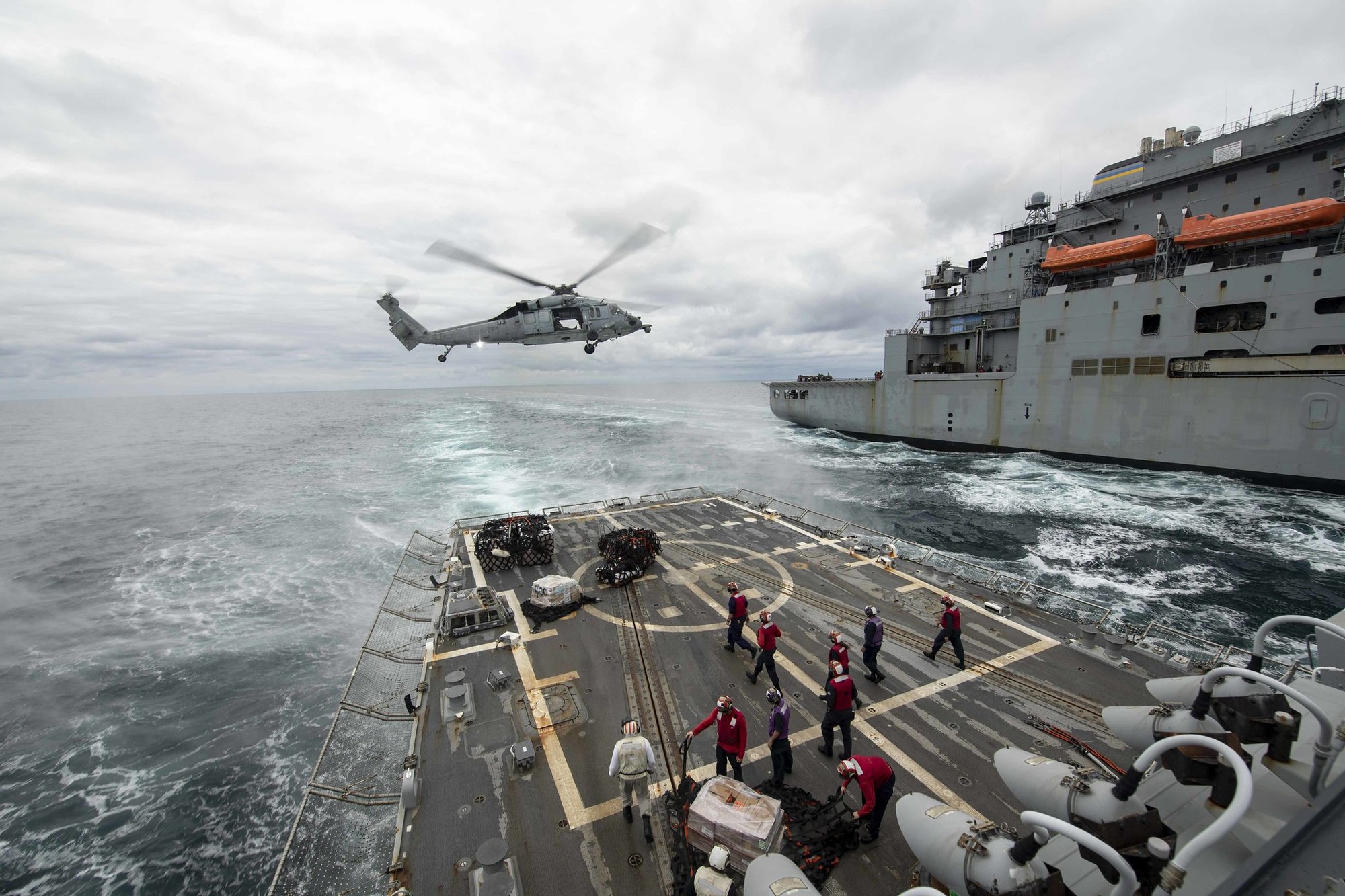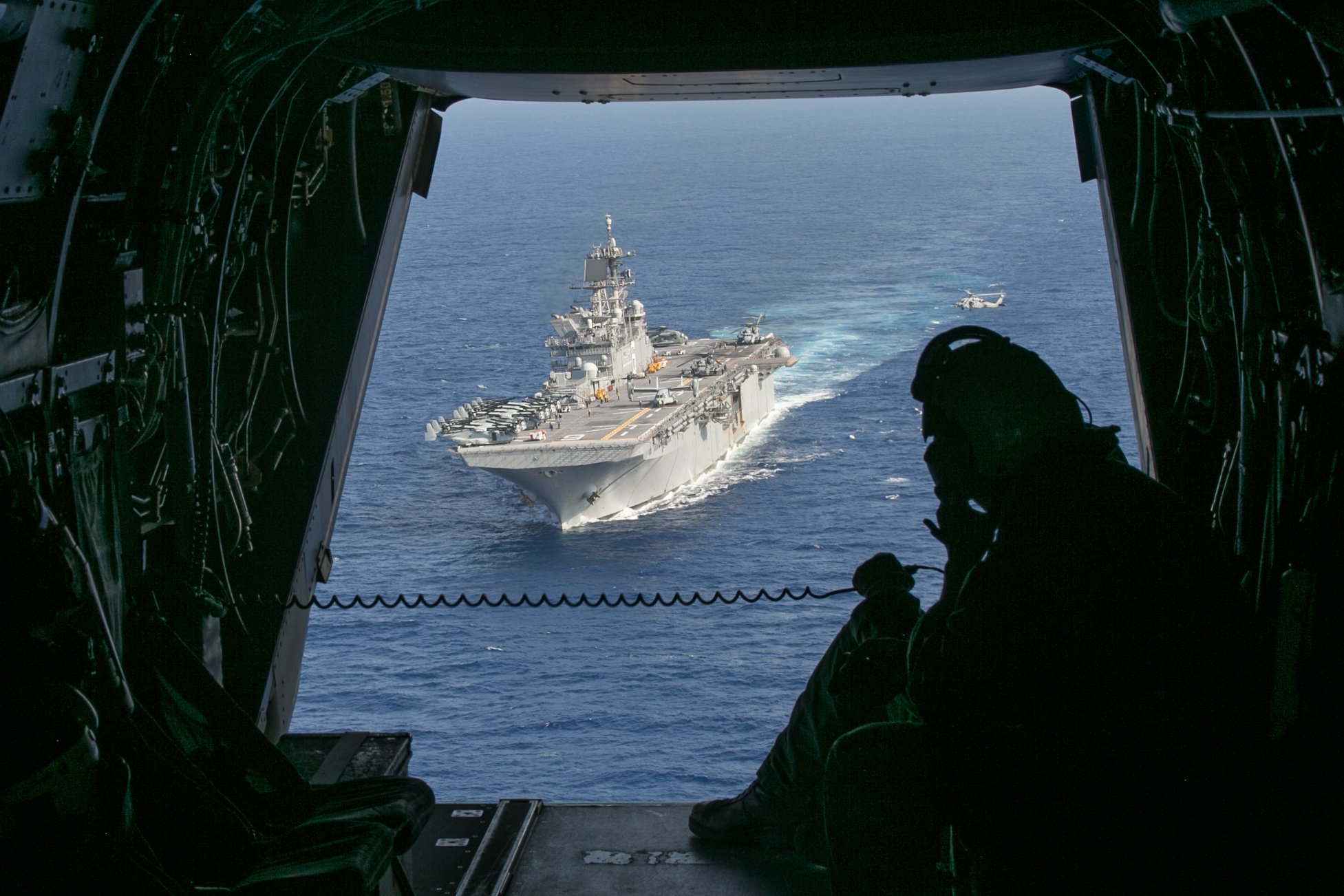Navy’s Shipbuilding Plan Calls for Massive Expansion To Counter China, Meet Future Threats

The Theodore Roosevelt and Nimitz Carrier Strike Groups transit the Philippine Sea in formation while conducting dual carrier and airwing operations, June 23, 2020. US Navy photo by Mass Communication Specialist Seaman Dylan Lavin
The Navy recently issued its 30-year shipbuilding plan. It’s extremely ambitious. From a current force of 296 ships, in 2045 the Navy will field 403. Unmanned ships will make that 546.
That’s nothing short of a transformation for the Navy. It has, to use common parlance, been sucking hind tit among the services for almost two decades. While there were convoys in Iraq and Afghanistan, they were the kind that needed MRAP escorts, not frigates. The Navy even sent some sailors ashore to FOBs to try to give the appearance that it was really needed.
Naval aviation acquitted itself well in both major campaigns, especially at the outset, but once a force has occupied a country for over a decade, the advantage of keeping a few squadrons on a floating airfield many miles from the actual battlefield decreased greatly.
It looks as if the tide has turned for the Navy, though. One way or another, it appears that the US will have a substantially reduced ground presence in the Middle East and Central Asia.

That’s just in time to support the pivot toward the Pacific that the US has been allegedly trying to do since the Obama administration. China is clearly the only country able to challenge US military dominance, and it has demonstrated its willingness to flex its muscle, both in claiming territory and in challenging its neighbors.
This may seem obvious, but there is a lot of ocean between the US and China. The islands that form the basis of the disputes between China and US allies are similarly surrounded by water. If the US is going to fight China, it has to be ready to fight and project power from the sea.
As the tri-service “Advantage at Sea” guidance points out, Chinese naval forces have tripled in size in the past 20 years. What’s more, while China has started to sail farther afield in recent years, its fleet is primarily concentrated in and near its home waters. That’s in addition to all the aviation and missile assets China can bring to bear in the region. In contrast, the US has to spread out its Navy to tend to recurring responsibilities and crises around the world, while still being prepared to play an away game against the Chinese.

The 30-year shipbuilding plan goes a long way to address this. While the US has historically centered its naval operations around a relatively small number of big-deck aircraft carriers, the new shipbuilding plan adds quantity to the equation. It adds light carriers, frigates, small amphibious ships, and most importantly unmanned naval ships. The last is a clear nod to a frightening implication of Chinese naval parity — that the US needs to be prepared to lose substantial numbers of ships in the event of war, something it hasn’t dealt with since WWII.
This isn’t the first time that the US Navy has planned to build up in order to go into the breach, though. A generation ago, the Reagan administration, spearheaded by Secretary of the Navy John Lehman, determined that the Navy would no longer plan to hang back and defend the Greenland-Iceland-United Kingdom (GIUK) Gap. It needed to be prepared to push north and attack the Soviet Union’s ports near the Kola Peninsula.
Lehman led a much-heralded effort to build a “600 ship Navy.” This effort started with a sprint at the beginning of the Reagan administration. Not only was there an ambitious shipbuilding plan, but the Navy extended the lives of older vessels and even brought some out of retirement. The most notable of these were the four Iowa-class battleships, which continued service through the 1991 Gulf War.
But even with the Cold War still raging, the momentum behind the naval buildup faltered. The Navy peaked at 596 ships in 1987, amid Congressional budget concerns. Secretary of the Navy James Webb abruptly resigned in 1988 in public dissent of Secretary of Defense Frank Carlucci’s backing away from the 600-ship goal with the retirement of 16 vessels.

The Defense Department’s rudder wasn’t steady enough to maintain a consistent Navy force structure plan, even within the same administration. This was during a decade of continually increasing defense spending.
Defense budgets are expected to be level at best in real dollars over the next several years. The new 30-year shipbuilding plan already explicitly depends on the Navy being able to take a bigger slice of the defense budget pie. The Army’s modernization plans already require a boost from the current Future Years Defense Program (FYDP).
That’s before the notoriously fickle US population and its elected representatives face world events that will inevitably distract them. Decades-long existential struggles have a difficult time holding public attention against the squirrels of high-profile terrorist attacks or tin-pot dictatorships poking the US in the eye. Throw in the personal idiosyncrasies of US presidents, and it’s amazing we get anything done at all.
The 30-year shipbuilding plan is a good idea and generally well conceived. The naval services are indeed the key to US national security for at least the next half-century. But unless the next several administrations make a bipartisan sustained effort to row in the same direction, it’s as doomed to run aground as the 600-ship Navy of the 1980s.

BRCC and Bad Moon Print Press team up for an exclusive, limited-edition T-shirt design!
BRCC partners with Team Room Design for an exclusive T-shirt release!
Thirty Seconds Out has partnered with BRCC for an exclusive shirt design invoking the God of Winter.
Lucas O'Hara of Grizzly Forge has teamed up with BRCC for a badass, exclusive Shirt Club T-shirt design featuring his most popular knife and tiomahawk.
Coffee or Die sits down with one of the graphic designers behind Black Rifle Coffee's signature look and vibe.
Biden will award the Medal of Honor to a Vietnam War Army helicopter pilot who risked his life to save a reconnaissance team from almost certain death.
Ever wonder how much Jack Mandaville would f*ck sh*t up if he went back in time? The American Revolution didn't even see him coming.
A nearly 200-year-old West Point time capsule that at first appeared to yield little more than dust contains hidden treasure, the US Military Academy said.












